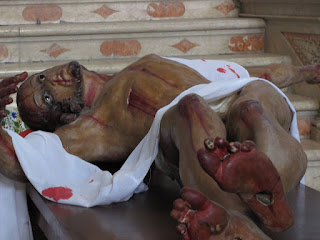We were awakened just before dawn by spray coming in the windows, thunder and drips from the ceiling onto our bed. An unexpected storm was raging outside, churning the sea and blowing water into the house. I moved through the house closing windows, but it was too late to prevent the floors from becoming flooded. The windows were also warped from the years of being near the ocean, so that didn't help keep the rain out either. The storm also blew out the power.
We were glad that the gardener, Ronaldo, came in early to check on us, and then get around to matter of getting the power back on, which didn't happen until the next day. It turned out that a main switch out by the road caught on fire and needed to be replaced. The challenge for Ronaldo was to find the part and then get the public utility workers to come to the home and install the part.
While Ronaldo worked on the house, we went to the old city of Salvador, the area called the Pelorinho. This was the square used by slave handlers to publicly whip and punish disobedient slaves. Here there are several museums, churches, restaurants and shops. It's also a good place to go to see a capoeira demonstration or hear some live music. We hired a guide, our home owner's nephew, Noah, to help use find our way around for the day. This was the only day this week that we didn't get lost.
Igreja de Ordem Terceiro de Sao Domingo
There are at least three large 18th century and 19th century churches positioned at the corners of the Pelorinho. The first one we visited was the Church of the Third Dominican Order. This church had elaborate paintings and sculptures depicting various stories from the scriptures and the lives of the saints. In true Portuguese tradition, they preferred the bloody stories and show them in all their graphic details.
These old churches also often have a museums of religious art. The ceiling in this church has an expansive painting. One our favorite pieces was this diorama with a giant Christ child and various scenes of from Christian history.
African Museum at the Medical School
A short walk from the church is the oldest medical school in Brazil, and this school also has a museum dedicated to the African history in Brazil. Brazil was the largest importer of African slaves, and their influence is very strong on Brazilian culture, especially in Salvador. At this museum, we learned a lot about Condomblé, a religion with African roots that worships various gods representing various natural phenomena and personalities called Orixás.
The museum also had on display art and handicrafts from Africa.
One of the most interesting rooms contained relief wood carvings of the Orixás. The carvings are exquisite and quite fun to see.
 |
| The main square of the Pelorinho |
At the suggestion of our guide, we ate lunch at the Bahia Café and Hotel that was conveniently situated on the way to our next stop: the public elevator and the market. The food was tasty and featured a variety of local stews and fish dishes, as well as sandwiches that were palatable for the younger members of our family. Prices were decent, and the portions were large enough that most dishes could be divided between two or three people. My oldest son finished off a large, breaded and deep-fried fish on his own. This was definitely the best seafood we've had since coming to Brazil.
This little hollow full of street cats in the center of the Praça de Sé was one of the kids' favorite spots. There were at least fifteen cats of various sizes and colors feasting on leftovers people had left on the steps.
 |
| A view of the lower old city. |
Mercado Modelo
 |
| A urinating demon (Orixú) and beverage dispenser. |
All the shopkeepers are willing to bargain and will often come down to about half the original asking price. They demonstrate the prices by typing the numbers into calculators.
This is also an area where tourists are advised to put cameras and other visible valuables away due to the chance of theft, especially when passing through the areas around the outside of the market.
Igreja de São Francisco
Our last stop before heading home was the church of São Francisco. This church is a great display of the riches during the golden period of Brazil's colonial days. The courtyard has two levels of walls adorned with white and blue tiles. The scenes depict stories of virtues and vices. These tiles were made in Portugal and then imported to Salvador.
The chapel is very ornate and nearly every carved piece is covered in gold leaf. It is a dazzling sight. One of my daughters said that even if the lights were out, the room would still glow due to the amount of gold.
 |
| A street leading up to the Pelorinho. |
We made it back home just after dark. A large toad that was feeding on flies greeted us in the carport. Unfortunately, the power was not yet restored to the house. They had been extremely busy responding to various service calls throughout the city. We managed to



























Great post.I'm glad to see people are still interested of Article.Thank you for an interesting read..
ReplyDeleteIB Syllabus Schools